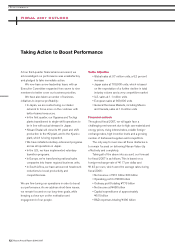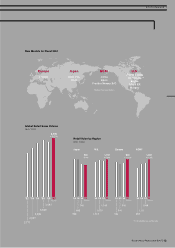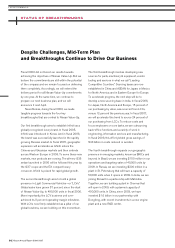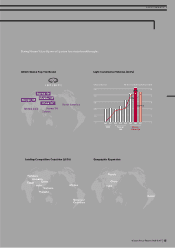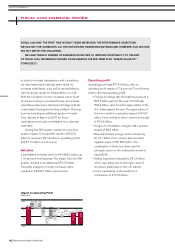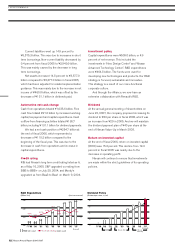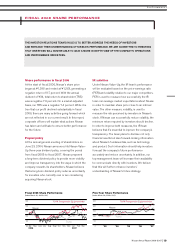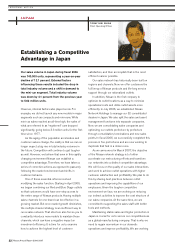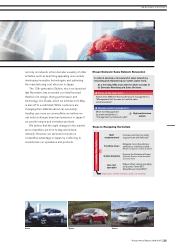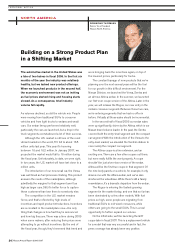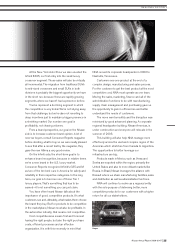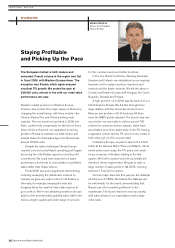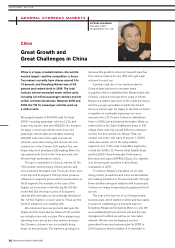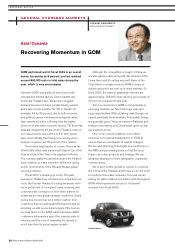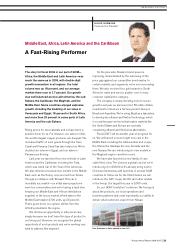Nissan 2007 Annual Report Download - page 24
Download and view the complete annual report
Please find page 24 of the 2007 Nissan annual report below. You can navigate through the pages in the report by either clicking on the pages listed below, or by using the keyword search tool below to find specific information within the annual report.
Nissan Annual Report 2006-2007
22
Our sales volume in Japan during fiscal 2006
was 740,000 units, representing a year-on-year
decline of 12.1 percent. External factors
influencing these results included the drop in
total industry volume and a shift in demand to
the mini-car segment. Total industry volume
was down by 4.1 percent from the previous year
to 5.62 million units.
However, internal factors also played a role. For
example, we did not launch any new models in major
segments such as compacts and mini-vans. While
mini-car sales reached an all-time high, the sales of
what are referred to as “registered” cars dropped
significantly, going below 3.6 million units for the first
time since 1977.
As the aging of the population accelerates and
customer values change, the reality is that we can no
longer expect a big rise in total industry volumes in
the future. Competition will continue to get tougher
as well. However, we believe that even in this rapidly
changing environment Nissan can establish a
competitive advantage. Therefore, we have taken a
series of corrective actions, as opposed to passively
following the market environment and shifts in
customer behavior.
One of these essential reforms involved
modifying the sales function. Starting in April 2005,
we began combining our Red and Blue Stage outlets
so that customers would have one-stop access to
the entire range of Nissan products. Having multiple
sales channels for one brand can be effective in a
growing market. But once market growth diminishes,
the multiple channel strategy is an inefficient way to
run a sales network. That structure also forces you to
constantly introduce new models to maintain those
channels, which can have a negative impact on
investment efficiency. It is time for us to examine
how to achieve the highest level of customer
satisfaction, and then accomplish that in the most
efficient manner possible.
Our sales network has historically been built on
regions and channels. Now we offer customers the
full lineup of Nissan products and life-long service
support through our rationalized outlets.
In addition, Nissan is the first company to
optimize its outlet locations as a way to minimize
operational costs and utilize outlet assets more
efficiently. In July 2006, we established Nissan
Network Holdings to manage our 52 consolidated
dealers in Japan. We also split the sales and asset
management functions into separate companies.
Now we are consolidating sales companies and
optimizing our outlets prefecture by prefecture
through consolidation, terminations and new sales
points. In fiscal 2006, we successfully completed this
process in five prefectures and are now working to
duplicate that feat in a dozen more.
As we announced in March 2007, the objective
of the Nissan network strategy is to further
accelerate our restructuring efforts and transform
our networks into a distinct competitive advantage.
We will focus on the quality of our sales interactions
and work to achieve outlet operations with higher
customer satisfaction and profitability. We plan to do
this by sharing best practices between outlet
operations and improving the capabilities of our
employees. Given the tougher competitive
environment we face, we are working on reducing
our indirect activities to improve the cost structure of
our sales companies. At the same time, we are
committed to supporting the sales staff with better
tools and methods.
Maintaining stable sales and higher production in
Japan is crucial for us to secure our competitiveness
as a global manufacturing company. That is why we
need to regain momentum in our domestic
operations and improve profitability. We are working
Establishing a Competitive
Advantage in Japan
JAPAN
TOSHIYUKI SHIGA
Chief Operating Officer
»REGIONAL ACTION


